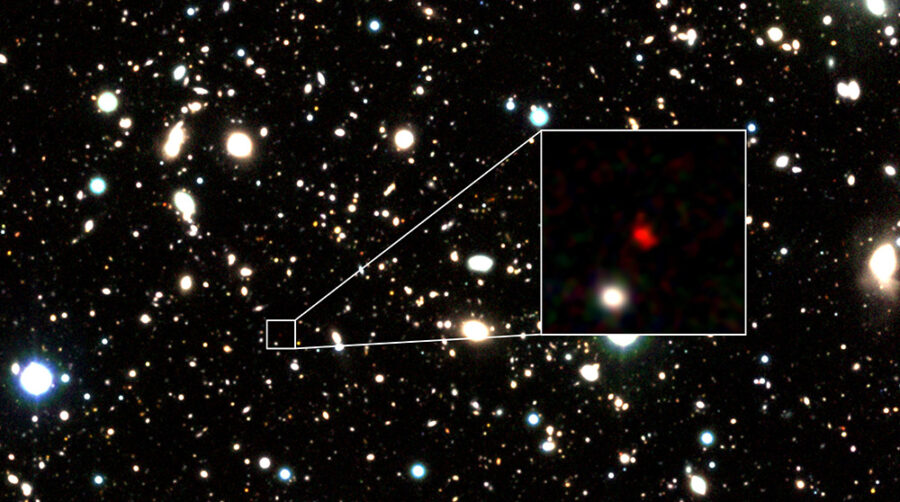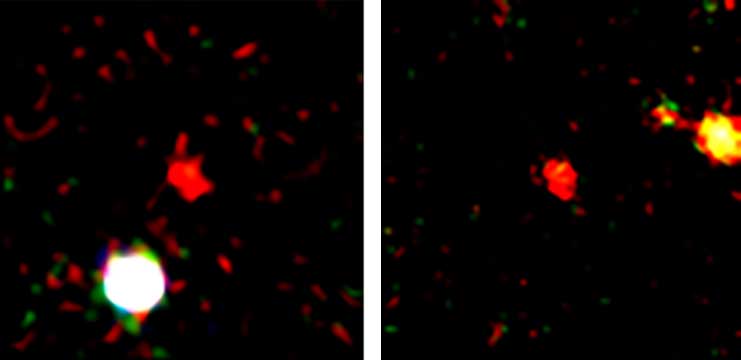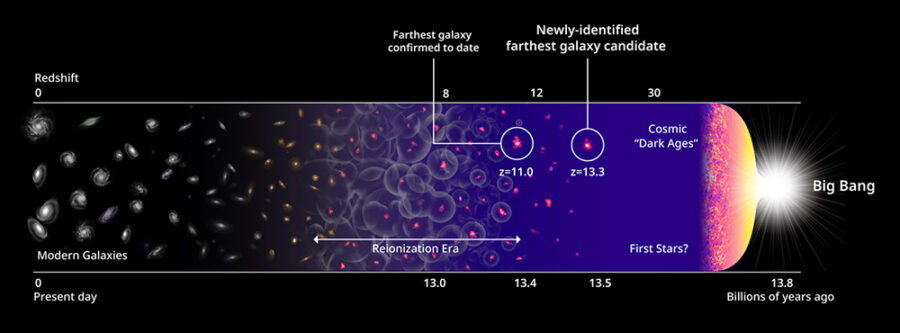Two fuzzy red objects in the early universe may be galaxies shining at us from only a few hundred million years after the Big Bang.
Editorial note (April 7, 2022): This story was originally published on January 26, 2022. The discovery paper is now accepted for publication in the Astrophysical Journal; the accompanying analysis is accepted for publication in the Monthly Notices of the Royal Astronomical Society. We have also updated images in the news story below.

Harikane et al.
Astronomers may have found the most distant galaxies ever seen. In two papers posted to the arXiv preprint server, Yuichi Harikane (University of Tokyo) and an international team report the detection of two sources that appear to blaze at us from a mere 330 million years after the Big Bang. In astronomers’ lingo, that corresponds to a redshift of 13. The studies have been submitted for publication but are not yet peer-reviewed.
Observers have previously found a handful of galaxies in the universe’s first few hundred million years. The current recordholder with a secure measurement is GN-z11, announced by Pascal Oesch (now at University of Geneva) and others in 2016. GN-z11’s redshift is about 11, meaning we see it as it was 420 million years after the origin of the observable universe. Other, less definitive finds suggest galaxies around this time had fairly mature stars, implying stars first lit up within the universe’s first 300 million years.
Even if the two new galaxies prove to lie as far away (and thus, as early) as they appear to, they likely are not from the population of first galaxies, Harikane says. Based on their brightness, the galaxies may contain at least 1 billion solar masses in stars — similar to the Magellanic Cloud dwarf galaxies, and too hefty to be the first generation. “We think that they evolved from smaller galaxies,” he says.

Y. Harikane et al.
Finding the First Galaxies
The first galaxies set the cosmic stage. Their stars created heavier elements (such as carbon and oxygen) than the simplest atoms made in the primordial inferno, and their black holes grew to be the behemoths we see today in the hearts of nearly every massive galaxy.
These supermassive black holes present a mystery. Scientists have spotted them as far back as 1 billion years post–Big Bang, but those early examples are far larger than expected — easily a billion times the mass of the Sun. It’s hard to explain how such gargantuas came together within a measly billion years. Finding the first galaxies (and their black holes) and figuring out what they were like when they formed will help astronomers solve this conundrum.
With these points in mind, Harikane’s team went looking for early galaxies in archival images from a combination of ground- and space-based telescopes, covering visible and infrared wavelengths. They hunted for galaxies detected at the longest, reddest wavelengths but invisible at shorter ones. That’s because photons with short, blueward wavelengths (specifically, those shorter than 91.2 nanometers) are easily absorbed by neutral hydrogen, either within a galaxy or in clouds lying between us and it. This creates what’s called the Lyman break in a galaxy’s spectrum. As the universe expands, the galaxy becomes more distant and its light stretches to redder and redder wavelengths, and this spectral marker in its light shifts redward. The light that does make it to us from the galaxy is all redward of the break, telling us approximately how much the light has redshifted and thus how far back in cosmic time we’re looking.
After scouring the images with both computers and eyes, the team found two candidates, called HD1 and HD2. Astronomers actually already knew of HD1 but had cataloged it as a much closer galaxy.

Y. Harikane et al.
The team next looked at HD1 with the ALMA radio telescope in Chile, to see if they could measure the object’s precise redshift, thereby confirming that the dropout technique had really turned up early galaxies. ALMA detected a hint of a strongly redshifted line from ionized oxygen. If real, then that ionized oxygen confirms that HD1 has a redshift of 13.27 — and bingo, we have the earliest galaxy yet seen. But if that spectral line is not what it seems, then HD1 and HD2 might lie more than a billion years later in cosmic history.
“These sources are very intriguing, but I am not yet 100% convinced about their extremely high-redshift nature,” Oesch says, lamenting the inconclusive ALMA detection.

Harikane et al. / NASA / ESA / P. Oesch (Yale University)
Surprisingly Bright
The two galaxies are brighter than expected for normal star-forming galaxies, as are some other candidates found in this era, including GN-z11. In a companion paper to the one announcing the discovery, Fabio Pacucci (Center for Astrophysics, Harvard & Smithsonian), Harikane, and their colleagues consider possible reasons for the puzzling luminosities.
They suggest that a combination of rampant starbirth and a madly gobbling black hole might make both HD1 and HD2 surprisingly luminous. Prolific star formation or an overzealous black hole could each alone explain the radiation, but that’s a bit harder to accomplish.
If researchers confirm that HD1 and HD2 are early galaxies, then these objects might be telling us that star formation was more efficient in the early universe. They could also shed light (pun intended) on how the first supermassive black holes formed and grew.
But if they’re instead from a later cosmic era, then they would add to growing evidence that many galaxies have evaded detection because they’re shrouded in dust, which makes them too dim and red for, say, the Hubble Space Telescope to pick up.
“Whatever the nature of these sources turns out to be, they are interesting,” Oesch says.
Harikane and several collaborators have already secured time on the newly launched James Webb Space Telescope to take infrared spectra of HD1, HD2, and a third candidate. They estimate that JWST and other planned space telescopes could together discover more than 10,000 galaxies at this early epoch.
References:
Y. Harikane et al. “A Search for H-Dropout Lyman Break Galaxies at z~13.” Posted to arXiv.org December 16, 2021. Submitted to the Astrophysical Journal.
F. Pacucci et al. “Are the Newly-Discovered z∼13 Drop-out Sources Starburst Galaxies or Quasars?” Posted to arXiv.org January 3, 2022. Submitted to Monthly Notices of the Royal Astronomical Society: Letters.
 6
6









Comments
Rod
January 26, 2022 at 2:56 pm
Good report and links provided, e.g. Are the Newly-Discovered z∼13 Drop-out Sources Starburst Galaxies or Quasars?, https://arxiv.org/abs/2201.00823
Cosmology calculators like https://lambda.gsfc.nasa.gov/toolbox/tb_calclinks.cfm show such objects are traveling in 4D space faster than c velocity. All objects with z => 1.4 are moving in 4D space faster than c velocity. There is a hyperspace component in the math where galaxies are assumed to travel in hyperspace faster than c but relative to each other closer by, slower than c.
You must be logged in to post a comment.
John-Murrell
January 28, 2022 at 4:49 pm
They are not traveling through space at above light speeds - the space between us and them is expanding which is a different thing
You must be logged in to post a comment.
Rod
January 29, 2022 at 8:54 am
This discussion will explain more and how 4D space is expanding faster than c velocity in the BB model, thus hyperspace used in BB model to explain redshifts 1.4 or larger. https://forums.space.com/threads/how-big-is-the-universe.53802/
The comoving radial distances for objects with z 1.4 or larger, are farther away from Earth than 13.8 billion light years distance. When you use the available cosmology calculators, the reported distances presented to the public is the look back time or light time distance. The comoving radial distance based upon 4D space, hyperspace, place the object much farther away then look back time distance today so when z=1.4 or larger, the comoving radial distances are more than 13.8 billion light years distance from earth. We cannot see those objects because it would take light longer to reach earth than the postulated age of the universe (using Special Relativity). More info on 4D space expansion I posted in this thread earlier, Our expanding universe: Age, history & other facts, https://forums.space.com/threads/our-expanding-universe-age-history-other-facts.53627/
You must be logged in to post a comment.
Andrew James
January 31, 2022 at 5:41 pm
Sorry. This makes little sense. Self referencing one's own words doesn't make it as fact.
You must be logged in to post a comment.
Rod
April 7, 2022 at 10:21 am
I was glad to see in the S&T report some caution about the redshift of 13.27 or so presented. I read the 01-April-2022 arxiv paper revision and found such comments too.
The arxiv.org report states, "Currently, the highest-redshift source ever detected with a spectroscopic confirmation is a galaxy at z = 10.957 (Jiang et al. 2021) with a stellar mass of MBH ≈ 10^9 Msun (Oesch et al. 2016), while the highest-redshift quasar is a galaxy hosting a black hole of mass MBH ≈ 1.6 × 10^9 Msun at z = 7.642...While not confirmed by spectroscopy, one source is backed by a 4σ signal of the [OIII]88µm line at z = 13.27 with the Atacama Large Millimeter Array (ALMA), further supporting the z ∼ 13 estimate. Although a confirmation of the redshift of these two sources will require spectroscopic observations, this claim paves the way to performing a deeper search into existing data to look for very high-z sources that could have been potentially missed thus far…"
Are the Newly-Discovered z∼13 Drop-out Sources Starburst Galaxies or Quasars?, https://arxiv.org/abs/2201.00823, revised 01-April-2022
You must be logged in to post a comment.
albert poncedeleon
April 7, 2022 at 2:08 pm
What would happen to our standing theories about the universe first moments if more and more of these farthest away galaxies continue to populate the observable farthest edge of the universe? Will that put into question the age and the big bang theory? Do these new findings may seem to question what it was supposed to exist in the early ages, or stages, of the big bang?
You must be logged in to post a comment.
You must be logged in to post a comment.